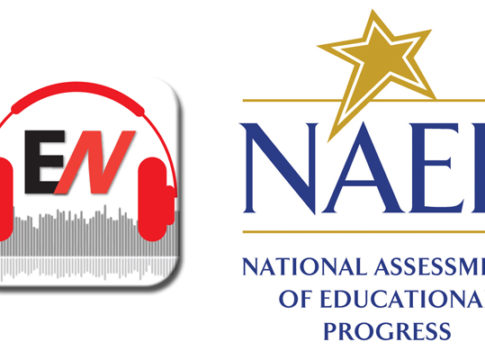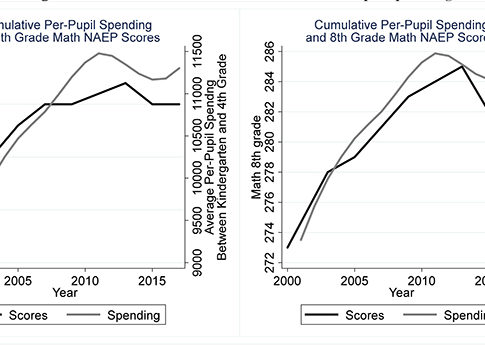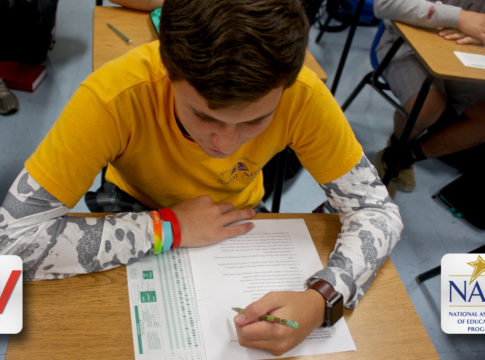Once every two years, the world of K–12 education holds its collective breath as it awaits the latest results from the National Assessment of Educational Progress (NAEP), often referred to as the Nation’s Report Card. The 2017 data, comprising math and reading scores for students in grades 4 and 8, arrived this April—and the news was not good. Scores ticked up in 8th-grade reading but otherwise remained flat, continuing a period of stagnation that’s now persisted for a decade.
 The flatline since 2007 is especially disheartening after a decade and a half of steadily rising scores. Gains around the turn of the millennium were most impressive in math. By 2007, 4th graders performed the equivalent of two grade levels higher and 8th graders performed the equivalent of one grade level higher than their counterparts in 1996 had. Black and Latino students made particularly encouraging progress, as did those at the bottom of the achievement distribution. In contrast, the 2017 results revealed a modest widening in the gap between low- and high-scoring students. They also confirmed that the surprising drop in performance evident on the 2015 NAEP, when scores fell on three of four tests, was no one-time blip but rather a real—and persistent—change.
The flatline since 2007 is especially disheartening after a decade and a half of steadily rising scores. Gains around the turn of the millennium were most impressive in math. By 2007, 4th graders performed the equivalent of two grade levels higher and 8th graders performed the equivalent of one grade level higher than their counterparts in 1996 had. Black and Latino students made particularly encouraging progress, as did those at the bottom of the achievement distribution. In contrast, the 2017 results revealed a modest widening in the gap between low- and high-scoring students. They also confirmed that the surprising drop in performance evident on the 2015 NAEP, when scores fell on three of four tests, was no one-time blip but rather a real—and persistent—change.
What explains these disappointing results? Ample evidence indicates that the gains students registered in the 1990s and 2000s were driven in large part by the adoption of test-based accountability systems, first on a voluntary basis by some states in the 1990s, and then by the rest under No Child Left Behind. However, as Mark Schneider, the incoming director of the federal Institute of Education Sciences, argued in 2011, the adoption of test-based accountability appears to produce a one-time increment in student achievement but does not seem sufficient to launch schools on a new trajectory of ever-higher performance (see “The Accountability Plateau,” December 2011). The latest results strengthen Schneider’s case—and suggest that simply defending test-based accountability in the Every Student Succeeds Act era won’t be enough to resume upward progress.
And what of the drop in performance since 2013? Commenting on the latest results for Education Next, Kirabo Jackson points a finger at declines in education spending in the wake of the Great Recession (see “Interpreting the 2017 NAEP Reading and Math Results,” April 2018). Although temporarily propped up by federal stimulus funds, average per-pupil spending nationwide fell after 2010. Jackson notes that the students tested by NAEP in 2015 and 2017 were the first cohorts to have experienced the brunt of that decrease, a drop of roughly $300 in per-pupil spending on average over the four years prior to each test. He also highlights new research linking post-recession spending reductions in specific districts to declines in achievement. Simply spending more may not be a reliable strategy to improve student achievement, but there’s good reason to believe that recent cutbacks have been harmful.
In fact, the resources available to students have declined by more than per-pupil spending figures would suggest. Michael Podgursky and colleagues documented how district payments for pension benefits grew from roughly $800 per student in 2010, when spending levels began to fall nationally, to more than $1,200 in 2017—a 50 percent increase over just six years (see “Pensions under Pressure,” features, Spring 2018). The bulk of this increase went to paying down debt on existing pension obligations, not to the direct costs of providing new benefits for current teachers. Such payments may be necessary, but they reap no benefit for today’s students—and could be one reason that teachers in several states have taken to the streets to protest stagnant pay.
Nor are pensions the only factor putting pressure on education spending. In this issue, Temple economist Doug Webber zeroes in on state higher-education spending, which has fallen substantially on a per-student basis over the past 30 years (see “Higher Ed, Lower Spending,” features). Webber combs through state budgets to ask a simple question—where has the money gone?—and finds a clear answer: Medicaid. States’ steadily growing obligations under the federal health-care program for low-income families and elders in nursing homes can explain the majority of the decline in higher-education spending. His conclusion: “constraining the rise of health-care costs is critical not just for those who care about health-care reform but for the public-higher-education landscape as well.”
Relative to higher education, K–12 schools have escaped such siphoning. Despite the recent decline, spending is still up substantially since 2005 and by an even greater amount over longer periods. But one wonders how long that will last, as the pressure from internal obligations and states’ competing commitments grows. That increasing tension may only heighten the challenge of putting American schools back on an upward trajectory.
— Martin R. West
This article appeared in the Summer 2018 issue of Education Next. Suggested citation format:
West, M.R. (2018). A Disappointing National Report Card. Education Next, 18(3), 5.





